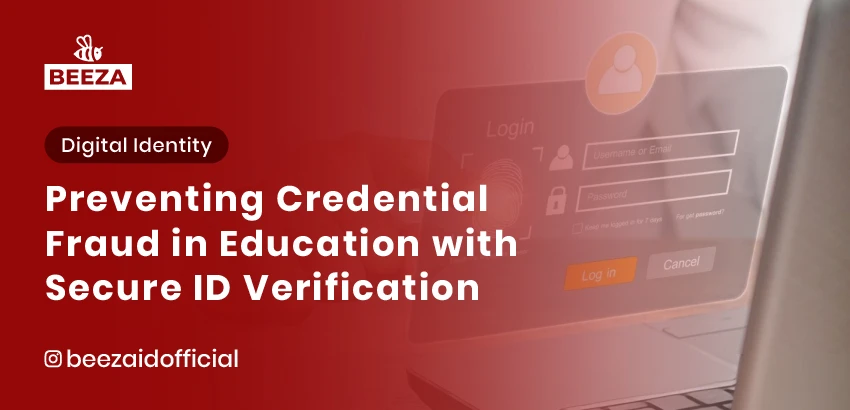
Credential fraud in education has become an increasingly pressing issue. With the rise of online courses, internet-based exams, and digital certifications, the authenticity of identities and academic credentials is more important than ever. Credential fraud, such as the use of fake identities or manipulated academic documents, not only harms educational institutions but also undermines the integrity of the education system itself.
To address this problem, many educational institutions are turning to secure ID verification solutions, such as biometric authentication and multi-factor authentication (MFA). This article will discuss how secure ID verification can help prevent credential fraud in the education sector.
Why Secure ID Verification is Important in Preventing Credential Fraud
Credential fraud in education often involves using fake identities to obtain certificates or degrees without meeting the required qualifications. This can harm universities, schools, and training institutions by damaging their reputation and credibility. Some reasons why secure ID verification is essential in preventing credential fraud include:
- Enhanced Security
Secure ID verification ensures that only legitimate individuals can access information or obtain credentials. Biometric technologies, such as facial recognition or fingerprint scanning, provide an added layer of security that is difficult to forge, compared to traditional methods like physical ID checks. - Ensuring Credential Authenticity
Secure ID verification allows educational institutions to ensure that the credentials issued, such as diplomas or certificates, are awarded to the correct individuals who meet the necessary qualifications. This reduces the risk of using counterfeit documents to gain unauthorized degrees or certificates. - Speeding Up the Verification Process
Manual verification of identities, such as checking physical documents, can be time-consuming and prone to human error. With secure ID verification, this process can be automated and completed quickly, ensuring that students or trainees can be verified accurately in a short amount of time. - Reducing Fraud Risk
By using more advanced verification technologies, educational institutions can detect and prevent fraud attempts early on. For example, if biometric data does not match the registered identity, the system will immediately alert administrators.
Challenges in Credential Verification Without Secure ID Solutions
Without secure ID verification, educational institutions face several challenges in ensuring the authenticity of credentials and preventing fraud:
- Vulnerable Security
Manual document checks are often insufficiently secure. Physical documents can be easily forged, and verification systems relying on passwords or PINs are also vulnerable to hacking. - Slow and Inefficient Processes
Manual credential verification can be slow, especially when dealing with large numbers of students or trainees. This can lead to delays in issuing certificates or diplomas, disrupting administrative processes. - Human Error
Manual verification is prone to human error, such as mismatched data or oversight in checking credentials. This can result in the wrong individuals receiving certificates or degrees. - Decreased Trust
If credential fraud cannot be prevented, the reputation of educational institutions is at risk. This can lead to a loss of trust from stakeholders, such as employers, government bodies, and prospective students.
Secure ID Verification Solutions to Prevent Credential Fraud
Here are some secure ID verification solutions that can help educational institutions prevent credential fraud:
- Biometric Verification
Biometric technologies, such as facial recognition, fingerprint scanning, or retina scanning, can be used to verify the identity of students or trainees with high accuracy. These methods are almost impossible to fake, making them an effective solution for preventing identity fraud. - Multi-Factor Authentication (MFA)
MFA combines multiple layers of security, such as a combination of passwords, one-time passcodes (OTP), and biometric verification. By using more than one method to verify identity, MFA makes it much harder for fraudsters to access credentials. - Digital Verification for Academic Documents
Using technologies like blockchain or digital signatures, educational institutions can verify the authenticity of academic documents, such as diplomas or certificates. This allows credentials to be verified without the need for physical document checks. - Digital Access Management Systems
Digital access management systems allow institutions to grant access based on verified identities. For example, only students who pass ID verification can access exam materials or receive certificates.
Case Study: Using Secure ID Verification at a University
Problem
A large university faced issues with credential fraud, where some students who did not meet the requirements were attempting to obtain fake diplomas. Additionally, the identity verification process for online exams was time-consuming and often led to errors.
Solution
The university implemented a secure ID verification system using facial recognition and fingerprint scanning to ensure that only legitimate students could take exams or receive certificates. They also used digital signature technology to verify the authenticity of diplomas and certificates.
Results
- A significant decrease in the number of credential fraud cases.
- Faster and more accurate identity verification, reducing human errors.
- Increased trust from employers and other institutions in the authenticity of the university’s credentials.
Conclusion
Secure ID verification plays a crucial role in preventing credential fraud in the education sector. By using biometric technologies, multi-factor authentication, and digital verification for academic documents, educational institutions can ensure that credentials are legitimate and secure. This not only improves security but also speeds up administrative processes and enhances trust in the education system.
If your institution is facing challenges related to credential fraud, implementing secure ID verification solutions could be a vital step toward maintaining the integrity and security of academic data.For more information Preventing Credential Fraud in Education with Secure ID Verification, please contact us. Visit Beeza.id for the business solutions you need.